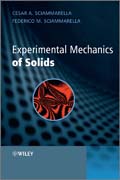
Modern experimental mechanics of solids: theory, techniques, instrumentation and applications
Sciammarella, Cesar
Sciammarella, Federico
Using extensive diagrams and illustrations, Modern Experimental Mechanics of Solids: Theory, Techniques, Instrumentation and Applications is a comprehensive introduction to the topics, technologies and methods of experimental mechanics of solids. It begins by establishing the fundamentals of continuum mechanics, explaining key areas such as the equations used, stresses and strains and two and three dimensional problems. Having laid down the foundations of the topic, the book then moves on to look at specific techniques and technologies with emphasis on the most recent developments such as optics and image processing. All of the current computer technology methods, as well as the practical ones, are included to ensure that the book provides information essential to the reader in practical or research applications. INDICE : Chapter 1 Continuum Mechanics 1 Historical Background 1.1 Definition of the concept of stress 1.2 Transformation of coordinates 1.3 Stress tensor representation 1.3.1 Two Dimensional Case 1.4 Principal Stresses 1.4.1 How to Calculate Principal Stresses after Making the Transformation 1.4.2 Maximum and minimum shear stresses 1.5 Principal stresses in two dimensions 1.6 The Equations of Equilibrium 1.7 Strain Tensor 1.8 Stress Strain Relations 1.8.1 Homogeneous or not? 1.8.2 Material Coordinate System 1.8.3 Linear, elastic, isotropic materials. Lamé Constants 1.9 Equations of compatibility Chapter 2 Theoretical Stress Analysis 2 Basic formulation of Continuum Mechanics Theory of Elasticity 2.1 Introduction 2.2 Fundamental assumptions 2.3 General Problem 2.3.1Boundary Conditions 2.4 St.-Venants principle 2.5 PLANE STRESS. PLAIN STRAIN 2.5.1 Solutions of problems of 2-D using the Airys stress function 2.6 Plane stress solution of a simply supported beam with a uniform load 2.7 Solutions inPlane strain and in Plane stress 2.8 The plane problem in polar coordinates 2.9 Thick Wall Cylinders Chapter 3 Strain Gages Introduction 3 Introduction to Electrical Strain Gages 3.1 Strain measurements point methods 3.2 Electrical Strain Gages 3.3 Basics of Electrical Strain Gages 3.3.1 Backing material 3.3.2Cements 3.3.3 Application of Gages onto surfaces 3.4 Gage factor 3.4.1 Derivation of Gage Factor 3.4.2 Alloys for strain gages 3.4.3 Semiconductor strain gages 3.5 Basic characteristics of electrical strain gages 3.5.1 Electrical resistance 3.5.2 Temperature Effect 3.5.3 Corrections for Thermal Output 3.5.4 Adjusting Thermal Output for Gage Factor 3.6 Errors due to the Transverse Sensitivity 3.6.1 Corrections due to the transversal sensitivity 3.7 Errors Due to Misalignment of Strain Gages 3.8 Reinforcing effect of the gage 3.9 Effect of the resistance to ground 3.10 Linearity of the gages. Hysteresis 3.11 Maximum deformations 3.12 Stability in time 3.13 Heat generation and dissipation 3.14 Effect of external ambient pressure 3.14.1 Additional consideration concerning the effect of pressure on strain gages 3.14.2 Additional environment effects to consider 3.14.3 Electromagnetic fields 3.15 Dynamic effects 3.15.1 Transienteffects 3.15.2 Steady State Response. Fatigue Characteristics of Strain Gauges Chapter 4 Strain Gage Instrumentation 4.The Wheatstone Bridge 4.1 Introduction 4.2 Derivation of the Wheatstone equilibrium condition 4.2.1 Variation of voltages in the bridge arms 4.2.2 Effect in the Bridge of a resistance present in the measuring branch of the bridge 4.3 Full bridge arrangements in some simple cases of loadings 4.3.1 Bars subjected to tension (case a) 4.3.2 Bars subjected to bending (case b) 4.3.3 Compensation of bending stresses (case c) 4.3.4 Bar subjected to torsion 4.4 Linearity errors
- ISBN: 978-0-470-68953-0
- Editorial: John Wiley & Sons
- Encuadernacion: Cartoné
- Páginas: 808
- Fecha Publicación: 23/03/2012
- Nº Volúmenes: 1
- Idioma: Inglés
